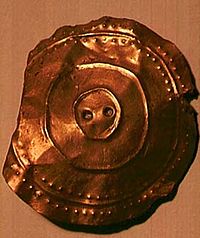Banc Ty'nddôl sun-disc facts for kids
Quick facts for kids Banc Ty'nddôl sun-disc |
|
|---|---|

Decorated with concentric line and dot circles and pierced by two central holes, apparently for attachment. The design was determined to belong to the Primary Bell Beaker Goldwork Tradition.
|
|
| Material | Welsh alluvial gold |
| Created | Beaker phase (c. 2000 BC) |
| Discovered | 16 October 2002 near Cwmystwyth, Ceredigion, Wales |
| Present location | Amgueddfa Cymru – National Museum Wales, Cardiff, Wales |
The Banc Ty'nddôl sun-disc is a small, shiny gold ornament. It was found in Cwmystwyth, Ceredigion, Wales. This special disc is over 4,000 years old. This makes it the oldest gold object ever found in Wales! It was likely worn as part of a special outfit for someone who had died.
Archaeologists found the disc on October 16, 2002. They were looking at old Roman and medieval sites. These sites were used for melting lead. The sun-disc was found near a Bronze Age copper mine on Copa Hill.
Contents
A Look Back in Time
The area around Cwmystwyth has a long history. People have been mining for lead and copper there for over 4,000 years. This started almost as soon as people began working with metals in Britain.
Finding the Sun-Disc
Archaeologists were digging at mining sites. They found that these sites were used by Romans around 1 AD. They were also used in the Early Medieval period, from the 800s to 1100s AD. But then they found something much older!
The gold disc was about the size of a milk-bottle top. It was more than 2,000 years older than the Roman and medieval finds. When they first found it, they weren't sure if it had been placed there on purpose. It was found close to the surface. This made them think it might have been moved from its original spot.
Because it was a valuable find, it was reported as "Treasure." This led to more digging in March 2003. They wanted to see if there were more hidden treasures nearby. They collected soil and charcoal samples to try and figure out its age. It was tricky to get an exact date. The bone fragments were too old, and the charcoal gave confusing dates. But these results still suggested it was from a very old, prehistoric burial.
What the Disc Looks Like
The disc is about 3.9 centimeters wide. It weighs about 2.5 grams. It's made of very pure gold, about 93-94% gold. The rest is mostly silver, with a tiny bit of copper.
It has cool designs on it. There are circles made of lines and dots. It also has two small holes in the middle. These holes were probably for attaching it to something. The design is similar to other gold items from the ancient Beaker culture.
The gold itself might have come from Ireland, Scotland, or Wales. It's called "alluvial gold," which means it was found in riverbeds. The disc was likely made for a special burial outfit. It might have been a symbol of the sun's power to give life.
Later, more digging at the site found human bones. These bones were once covered by a pile of stones called a cairn. The grave faced west, looking down the valley. It was a special resting place for someone who wore one of Wales's first gold objects.
Similar Discoveries
Similar gold discs have been found in other places. These include Ireland, the Isle of Man, and Brittany (in France). Most of these "sun-discs" have been found in Ireland (21 of them). A few have been found in Scotland (6) and England (5). This disc is the first of its kind found in Wales. It's thought to be the oldest gold artifact from Wales. It probably dates to the Beaker period, around 2000 BC.
The Banc Ty'nddôl disc looks a lot like one found in Ireland. It also has similar lines and two holes. Another similar disc with dots was found in Kirk Andreas on the Isle of Man. In Brittany, gold discs with similar designs were found in very old tombs.
In Britain, three similar discs were found in Beaker culture burials in Wiltshire. Two were found together, and one was found alone. The style of the Banc Ty'nddôl disc is very similar to "basket earrings" or gold hair ornaments. These were found in rich Beaker burials. For example, some items from Kirkhaugh in Northumberland have similar markings. These items from Kirkhaugh and other sites date back to between 2500 and 1900 BC.
Where It Is Now
The Banc Ty'nddôl sun-disc was officially declared a "treasure" in December 2003. Since then, it has been bought by the National Museum Wales. You can see it there today!
Gallery
-
Cwmystwyth mines, located near where the disc was found.
Archaeologists Who Worked on This
- Simon Timberlake: Director of Excavations, Early Mines Research Group.
- Adam Gwilt: Expert in Later Prehistory, National Museum & Gallery of Wales.
- Mary Davis: Archaeological Conservator, National Museum & Gallery of Wales.



